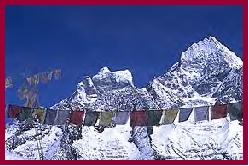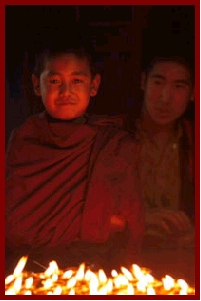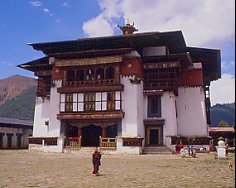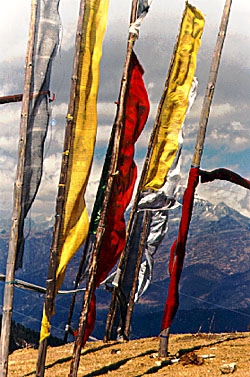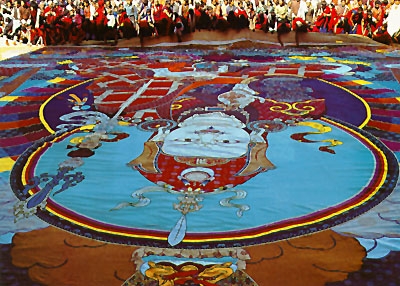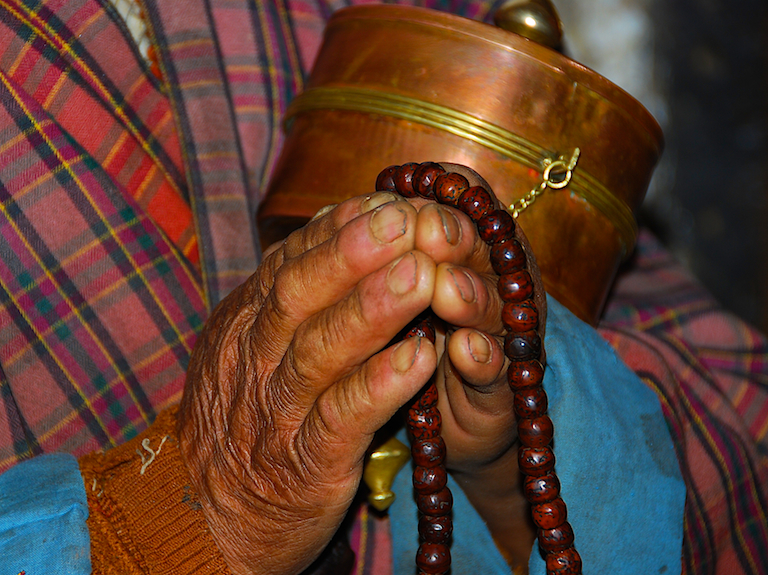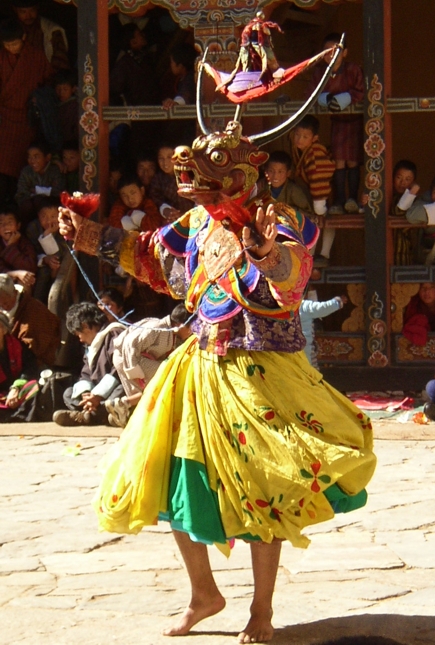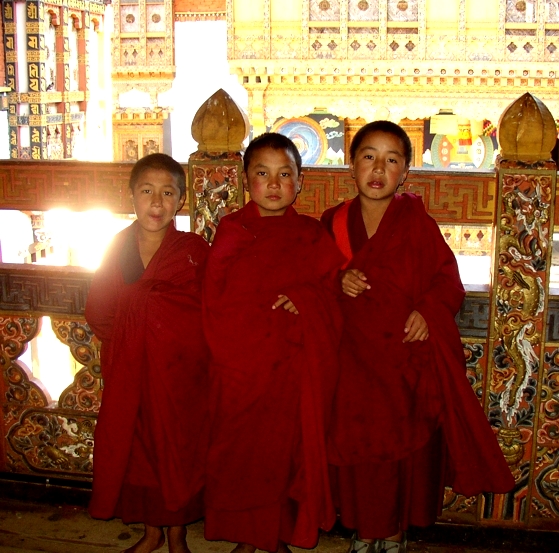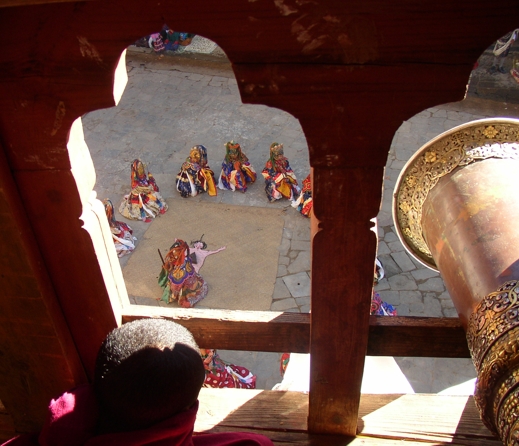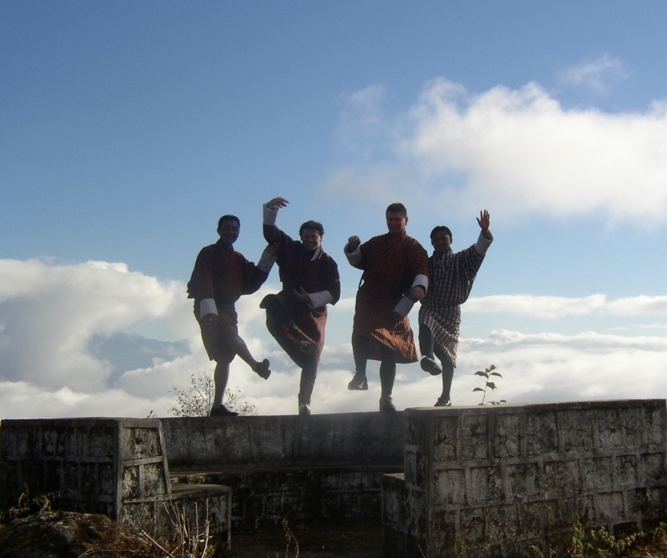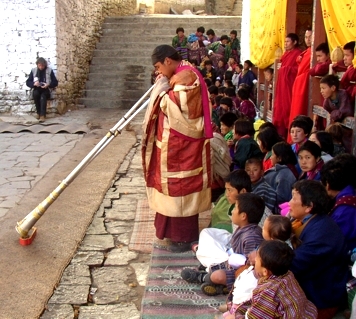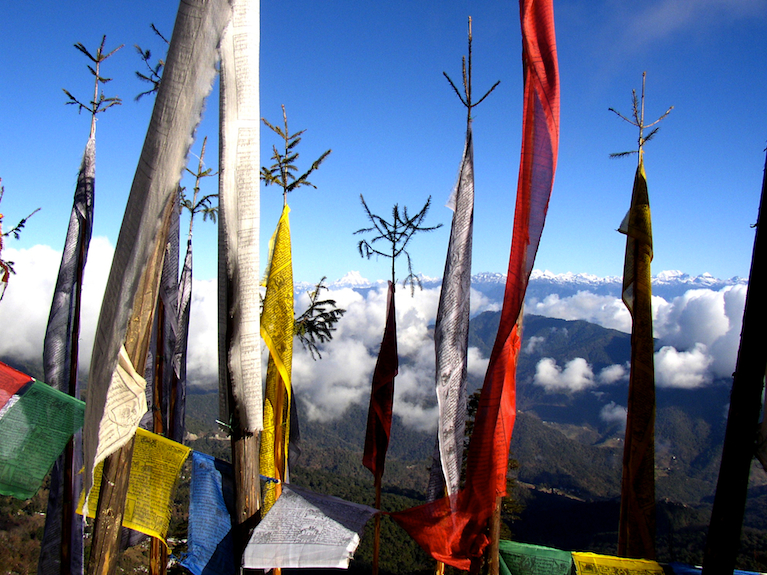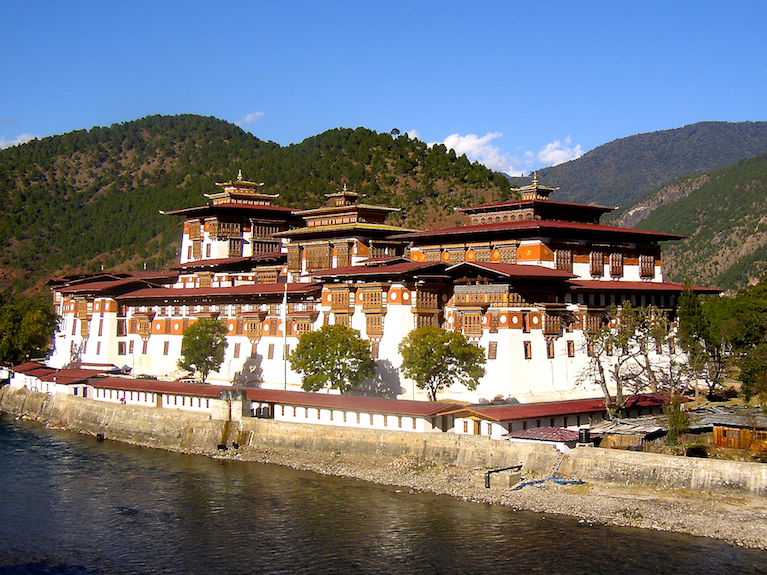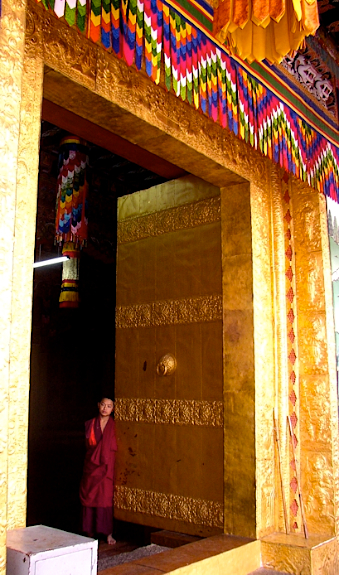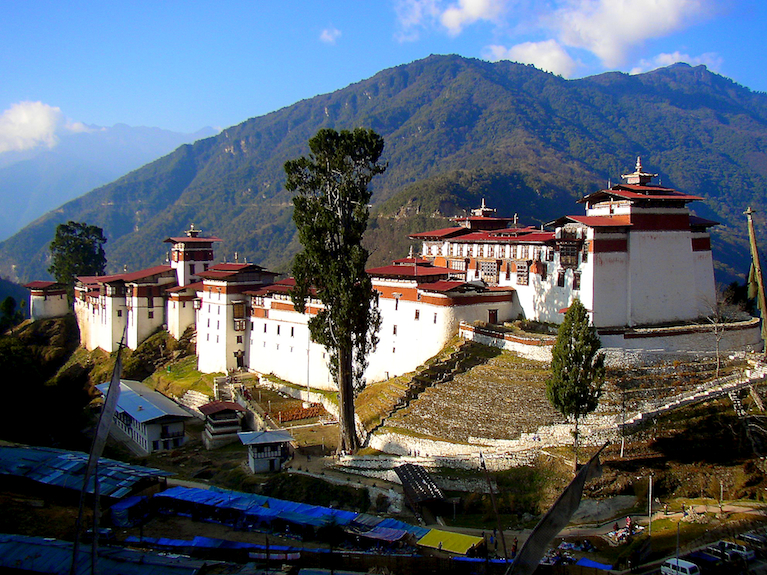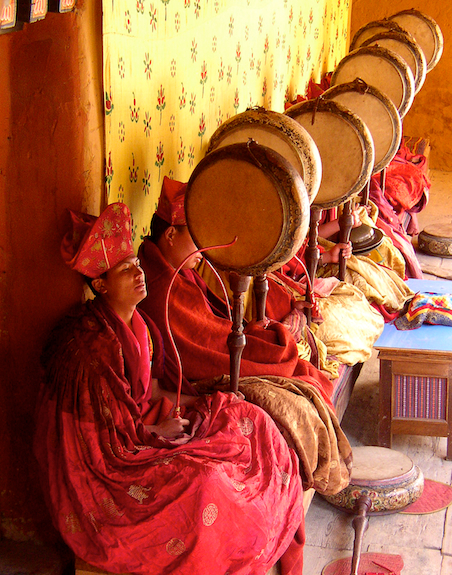BARRON ADVENTURES
THE LAST HIDDEN HIMALAYAN
KINGDOM
LAND OF THE THUNDER DRAGON
TRONGSA TSECHU
(MASKED DANCE FESTIVAL)
SACRED TEMPLES & MONASTERIES
ANCIENT CITIES OF
THIMPHU, PARO, PUNAKHA, TRONGSA
REMOTE TRADITIONAL BUMTHANG REGION
TAKTSANG MONESTERY
EXOTIC CULTURES, COLORFUL PEOPLE, UNSURPASSED NATURAL BEAUTY


The hidden kingdom of Bhutan has been isolated from the outside world for centuries. Bordered by Tibet and India, only a few outsiders are permitted into the country each year. Bhutan is an extraordinary place hardly touched by the hands of time. Nestling in the heart of the great Himalaya, it has remained in self-imposed isolation, aloof from the rest of the world. Few westerners have experienced its riches. Known by its people as Druk Yul - The Dragon Kingdom, the environment is pristine, the scenery and architecture awesome, the people hospitable and charming, and the fascinating culture unique in its purity. This trip centers on a very remote Bhutanese Tsechu (festival), a kaleidoscope of whirling dancers in colorful costumes, beautiful singers, mischievous jesters, long temple horns, drums and cymbals, and thousands of locals dressed in their finest clothing and jewelry, which only a handful of outsiders have witnessed. Experience a once in a lifetime opportunity to explore this rich untouched culture, and explore its magnificent Himalayan mountains and valleys. Take a step back in time for a glimpse of traditions and customs disappearing from the rest of the Himalayan world. Discover this incredible unspoiled jewel. Bhutan is truly the real Shangri-La. (Scroll down for itinerary)
ITINERARY
Day 1-2 USA-BANGKOK
Fly from home city, arrive in Bangkok, Thailand.
Depending on airline, overnight in Bangkok or
connect to Bhutan flight.
Day 3 BANGKOK - PARO (BHUTAN)
The spectacular flight to Paro is awe inspiring, with breathtaking
views of Himalayan peaks, including the sacred Chomolhari “Abode of the Goddess” and Mount Jichu Drake in Bhutan. Lunch in Paro, and a drive through the magnificent Paro Valley to our hotel. After lunch we visit Ta Dzong (the National Museum), which towers above the Paro Valley, and view the very interesting collection of historic artifacts. Then Paro Dzong, a massive fortress monastery. We walk across its beautiful wooden roofed bridge and guardhouses to enter the Dzong, which is the administrative seat of the Paro district and contains a state monastic community of about 200 monks. We take a short drive to Kyichu Lhakhang, one of the most sacred temples in Bhutan. Bhutanese history says that this temple was one of the 108 temples built in a single day in 659 AD by Tibetan Buddhist King Songtsen Gampo. Pilgrims come from all over the region to worship at this sacred site. Later explore Paro's interesting main street. Overnight Paro hotel. (L,D)
Day 4 THIMPHU
After breakfast drive through the dramatic Paro Chhu and Wang Chhu river valleys to Thimphu, Bhutan's capital city. Thimphu was a wooded farming valley up until 1961, when it became Bhutan’s official national capital. Its population is composed of monks, the royal family, government and civil service and a large growing middle class. The city is notably without traffic lights, as is the entire country. We visit the National Memorial Chorten, a 169ft tall Bronze Buddha statue over looking Thimphu valley and Tashichho Dzong, the main secretariat building. A massive fortress, Tashichho Dzong, houses part of the government Ministries, the office of the King and the Throne Room. It also houses the State Monastic Body and the office and the living quarters of the Chief Abbot. Next the Folk Heritage Museum, Bhutan Handicraft Emporium. Then on to Changangkha Lhakhang Temple built in the 12th century, and the Takin sanctuary. The Takin is a bizarre looking creature found only in a few Himalayan areas and is the national animal. It seems to have been and assembled from a variety of zoological sources giving a cartoonish appearance. Resembling an ox, beaver, goat, yak and antelope, they are sometimes referred to as a "beestung moose." Evening free to roam the town and its interesting shops. Thimphu (2320m). Overnight Thimphu. (B,L,D)
Day 5 THIMPHU - PUNAKHA
After breakfast, travel to Punakha. On the way halt at Dochula la Pass (3116 m) for a hot cup of tea/coffee and witness a most spectacular view of the Eastern Himalayan mountain ranges. After lunch we visit the Punakha Dzong, which houses the district administration offices, and is literally one of the most beautiful structures of this type in the world, inside and out. It is also the winter residence of the State Monastic Body and its Chief Abbot. Punakha was the former capital of Bhutan. The Dzong (fortress) lies between two rivers, the Pochu and Mochu, "Male and Female Rivers", built in 1637 AD. Later drive to Kabesa and hike across a long suspension footbridge through terraces of wheat fields to the Khamsum Yuelley Namgyel Chorten, a monument recently built by Ashi Tshering Yangdon Wangchuk. Punakha (1300 m) Overnight Punakha. (B,L,D)
Day 6 PUNAKHA – TRONGSA
After breakfast we travel overland and cross Pelela Pass (3390 m), ascending through farmhouses and grazing yaks, to Chendibji Chorten, built in Nepalese style with gigantic Buddha's eyes painted at the four cardinal points. Crossing the Black Mountains, which separate western and central Bhutan, we enter a part of the country that until the l970’s was only reached by mule and foot trails. We continue on the one road towards Trongsa in literally the middle of the country, over mountain passes and though lush valleys, passing fluttering prayer flags. Overnight Trongsa (B,L,D)
Day 7 TRONGSA - BUMTHANG
Continue east for Bumthang over Yotongla pass (3425 m). Bumthang is Bhutan’s spiritual and cultural heartland and the region encompasses four major valleys: Choskhor, Tang, Ura and Chumey. Bumthang (2575 m). This remote eastern area is retains a more traditional life than in Thimphu and Paro. Time permitting we meet a traditional healer or shaman, and later join an archery competition. Overnight Guesthouse, Jakar (B,L,D)
Day 8 BUMTHANG
We rise early to join the morning rituals of the local monastery. Young monks are called with the banging of cymbals into the temple and we join them in a small shrine room listening to their remarkable chanting filling the room. Those who wish can don the heavy iron chain coat, with thousands of links, said to have been fashioned in one day by the 17th century monastery’s founder, and walk three times around the temple to wash a lifetime of sins away. Then we visit of Jakar Dzong also built in 17th Century and then Jambay Lhakhang built in 7th. According to Bhutanese history books, Guru Rinpoche, the central figure in Tibetan Tantric Buddhism, visited this valley in the 8th century and hid treasures of enlightenment (termas) throughout this valley and Bhutan. Once these treasures are discovered by a “revealer”, the benefit inherent in the treasure is dispersed and a monument, commemorating the great event, is often constructed. Kurjey Lhakhang, the monastery where Guru meditated, is one such place, and according to local lore one can see the imprint of Guru Rinpoche’s body on the rock where he once sat. Then walk to Chamkhar Chhu and Tamshing Lhakhang built in 1501 and founded by the great “revealer of treasures, Pema Lingpa. It contains exquisite paintings and statuary, said to date back to back to the time of the great revealer himself. Later free to explore Jakar town. Overnight Jakar. (B,L,D)
Day 9 BUMTHANG - TRONGSA
Drive to Trongsa and stop at the Zhugney Yathra weaving center and then continue over Yotong La pass. Trongsa Dzong is considered by many to be the most beautiful in all of Bhutan. Constructed in multilevels, it is situated at an elevation 2100 m, perched on the edge of a mountain ridge. There will be festivities outside the Dzong as well as the Buddhist Tsechu inside. Archery and dart contests, fortune telling, trading goods, etc. Overnight (B,L,D)
Day 10 TRONGSA TSECHU
You have a full day to at Trongsa Dzong to witness the magnificent Trongsa festival. Very very few westerners have experienced this incredible spectacle. The Trongsa Tshechu is a festival honoring Guru Padmasambhava, "one who was born from a lotus flower." This Indian saint contributed enormously to the diffusion of Tantric Buddhism in the Himalayan regions of Tibet, Nepal, Bhutan etc. around 800 AD. He is the founder of the Nyingmapa, the "old school" of Lamaism. The biography of Guru is highlighted by 12 episodes of the model of the Buddha Shakyamuni's life. The local people in the Trongsa valley celebrate their annual festival after the harvest during the winter. This festival, held in the courtyard of this incredible fortress is one of the most spectacular festivals in Bhutan. The Tshechu is a religious festival and by attending it, it is believed one gains merit. It is also a yearly social gathering where people gather from the mountains and valleys, dressed in all their finest clothing and jewelry, and come together to rejoice. Monks and lay Monks perform the dances with fantastic masks and ornate robes. Local women sing beautiful songs and long temples horns and loud cymbals and drums beat the time. Dance of the Terrifying Deities, Dance of the Celestial Beings, Dance of the Black Hats with Drums (Zshana Nga Cham) The “Black Hats” wear large brimmed black hats, felt boots, colorful brocade with ornate long dresses and robes. This is a victory dance following the destruction of the evil. The Black Hats beat the drums whose sound resounds throughout the Three Worlds. Peling Ging Sum: Dance of the Three Kings of Ging (Gingsum ) (Driging ) (Ngaging) The Gings wear knee-length greatly ornate skirts and robes. The first part of this dance is performed with sticks and animal masks; the second with swords and fierce masks. This mask dance symbolizes victory of good over evil. Overnight Trongsa (B,L,D)
Day 11 TRONGSA – WANGDUE PHODRANG
The road to Wangdi descends from the pass through the magnificent pine and rhododendron forests and wanders through some of Bhutan's most spectacular countryside. We visit the beautiful Wangdue Dzong, at an elevation of 1300m is uniquely perched at the end of a narrow peninsula ridge, high cliffs on all sides but one, hundreds of feet above the river valley. Overnight Wangdue. (B,L,D)
Day 12 WANGDUE PHODRANG - PARO
This morning we depart for Thimphu. On the way we can also take a walk to Chimmi lhakhang, a fertility temple built by Lama Drukpa Kuenley, where women hoping to bear children ask for fertility blessings. We stop to visit one of the beautiful farmhouses along our route. Rare visitors are welcomed at virtually any house throughout the countryside, as one gains merit by inviting and sheltering travelers. We will be offered tea and nuts or biscuits and share our stories with the house owners. Later lunch in Thimphu and stop by the shops to check out their latest wares and souvenirs. Then it's on to Paro, with the afternoon free to wander the town. Overnight Paro. (B,L,D)
Day 13 PARO – TAKTSANG
After an early breakfast, drive to Satsam Chorten for our hike to Taktsang Monastery. This fantastic fairytale-like temple complex is truly one of the world’s most spectacular structures. Not only for its beautiful temples, but also for it’s dynamic location, located at 2950m, perched on a sheer cliffs edge, 2500ft above the valley floor. The only access to the monastery is to hike the trail up from the valley. Taktsang, with its 13 holy places, is one of the most venerated pilgrim sites in the Himalayan world. The name Taktsang means Tiger's Nest. Legend has it that Guru Padmasambhawa, believed as the second Buddha, or Precious Teacher, flew to the site of the monastery on the back of tigress and then meditated there in the cave for three months. Our trail slowly rises above the valley, continuing across an open meadow we travel up a section of trail to a ridge where hundreds of prayer flags rustle in the wind next to a massive prayer wheel. We stop at a beautiful teahouse half way up for a short rest and refreshment. We then hike trail until a few hundred feet from the aerie, and then climb the last narrow hewn steps and spend most of the day exploring this spectacular site, returning to the teahouse for lunch before hiking down to the valley. Time permitting, we visit Drugyel Dzong, the ancient victorious fortress of the Drukpas. The Dzong was built in 1649 by Shabdrung Nawang Namgyel to commemorate the victory of Bhutan over Tibetan Invaders in 1644. On a clear day you can see spectacular view of sacred Mt. Chomolhari from the vicinity of the Dzong. On the way back to our hotel we visit Kyichu Lhakhang, one of the most sacred temples in Bhutan. Bhutanese history says that this temple also was one of the 108 temples built in a single day in 659 AD by Tibetan Buddhist King Songtsen Gampo. Pilgrims come from all over Bhutan, and throughout the globe, to worship at this sacred site. Overnight Paro (B,L,D)
Day 14 BANGKOK - USA TASHI DELEK!
Depart Bangkok for USA, and if schedule provides, arrive home the same day. (B)
FOR MORE INFORMATION CLICK THE "CONTACT US" BUTTON OR:
LAND COST:
$3990 10-12 members
4290 8-9 members
4690 6-7 members
INCLUDES:
- Hotels and lodges
- All meals in Bhutan
- Bhutan visa
- Fees and permits
- Internal transportation
- American guide
- Local guides in Bhutan
DOES NOT INCLUDE:
- Airfare
- Liquor, laundry, tips
- Airport departure tax
BARRON
ADVENTURES
Adventures, Treks, Expeditions Worldwide
PHONE (562) 592 2050 FAX (562) 592 2099
BOX 100, SUNSET BEACH, CA, USA 90742

